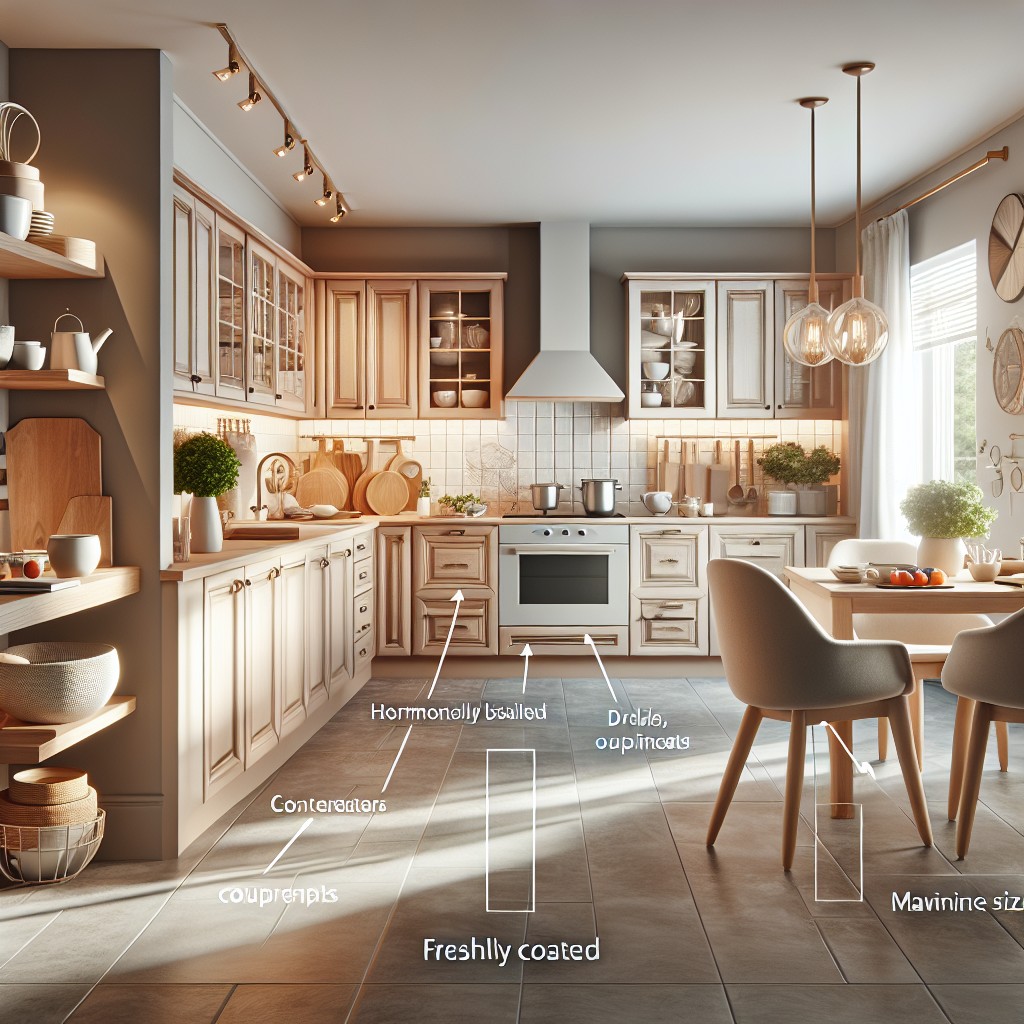Last updated on
Discover straightforward insights on making an informed decision when planning to paint your kitchen cabinets, including factors that influence the cost and how to budget effectively for this home improvement project.
Key takeaways:
- Paint cost for a standard 10×10 foot kitchen: 0 to ,800.
- Consider the number of cabinets: 0 to 0 per door, to 0 per drawer, or to per linear foot.
- Factors affecting cost: size, design, material, prep work, and finish.
- DIY or professional? Consider skill level, time, and complexity.
- Save money: embrace DIY, shop sales, borrow tools, limit color changes, quality paint, use primer wisely.
What's Inside
Cost to Paint Kitchen Cabinets

Assessing the cost of a kitchen cabinet paint job starts with two main factors: the size of the kitchen and the quality of the materials.
For a standard 10×10 foot kitchen, homeowners might spend between $900 to $3,800, which factors in labor if hiring a professional.
Materials alone may range between $200 to $600, depending on the quality of paint and supplies selected.
The number of cabinets plays a pivotal role too.
On average, it costs about $100 to $200 per door, $70 to $100 per drawer, or $30 to $60 per linear foot of cabinets, providing a clear ballpark for any kitchen size.
Remember, the paint type matters: oil-based paints may be more durable and provide a smoother finish but come at a higher cost than latex-based paints, which are easier to clean and apply.
If there’s existing damage or wear, prep work like sanding or priming can also add to the bottom line.
So, keep in mind that while you might be quoted a flat rate, these additional tasks will impact the final investment.
Factors That Affect the Cost of Painting Kitchen Cabinets
When considering a fresh coat of paint for your kitchen cabinets, the price tag is influenced by several elements.
First up, size matters. Larger kitchens with more cabinets mean more surface area to cover, leading to higher costs for both materials and labor. If you’re only sprucing up a few drawers and doors, your wallet will breathe easier.
Next, the cabinet design plays a role. Intricate designs with detailed moldings and raised panels may look stunning, but they also require more time and precision to paint properly.
Material is another key point. Wood, laminate, and metal each call for specific types of paint and treatment—this specificity can impact your overall cost.
Prep work is the unsung hero of a seamless paint job. If your cabinets are a bit worn and need sanding or repairs before painting, this preparation will add to the total cost.
And let’s not forget the finish. High-quality paint with a luxurious finish may have a steeper price than basic options, but it can significantly affect durability and appearance.
Lastly, location, location, location. Depending on where you live, labor costs can vary widely. Metropolitan areas typically come with a higher price tag for professional services.
Understanding these factors will make budgeting for your kitchen cabinet makeover a much smoother process.
DIY Kitchen Cabinet Painting Vs. Hiring a Professional
Embarking on a DIY project can be a fulfilling and cost-effective approach. With a moderate investment in paint, primer, and basic tools, one can initiate the transformation process. Prior experience in painting or a willingness to learn through tutorials enriches the undertaking. However, patience is paramount, as a meticulous finish requires unhurried, strategic layering and drying times.
On the flip side, hiring a professional comes with the assurance of expertise. Professionals bring high-grade equipment and profound knowledge of techniques to achieve a uniform and durable finish. Their services factor in the cost of labor, quality materials, and potentially a warranty. This route alleviates the burden of time spent and the risk of errors for homeowners.
When deliberating between DIY and professional services, consider your skill level, the value of your time, and the project’s complexity. For simple repaints, the DIY route can be quite manageable. However, for more extensive modifications or if the cabinets need significant repair before painting, a professional’s nuanced touch might prove invaluable.
How to Save Money When Painting Kitchen Cabinets
Opting to rejuvenate your kitchen cabinets with a fresh coat of paint is both cost-effective and transformative. Here are some smart strategies to keep expenses to a minimum:
1. Embrace DIY: Roll up your sleeves and tackle the project yourself. You’ll save significantly by not paying for labor. With online tutorials aplenty, you can learn proper techniques to ensure a professional-looking finish.
2. Shop Sales for Supplies: Keep an eye out for discounts on paint and painting supplies. Timing your project around major sales events can lead to substantial savings on high-quality products.
3. Borrow Tools: Rather than purchasing new equipment, see if you can borrow essentials like sanders or sprayers from friends or family. Alternatively, explore rental options from local hardware stores.
4. Limit Color Changes: If you’re updating the color but not altering the type of paint (e.g., staying with oil-based paint), you’ll likely need fewer coats, reducing the amount of paint needed.
5. Prep Work is Key: Proper preparation can prevent the need for additional coats of paint. Thoroughly cleaning and sanding your cabinets ensures the paint adheres well, which saves on supplies in the long run.
6. Quality Over Quantity: Invest in high-quality paint. It may cost more upfront, but it can cover better and last longer, which means you’ll save money over time by avoiding frequent touch-ups or repaints.
7. Use Primer Wisely: If your cabinets are already a light color, you might be able to use a paint-plus-primer product or even skip the primer altogether, cutting down on both costs and labor.
Implementing these tips can lead to a satisfying balance between economy and elegance, turning this home improvement project into a rewarding investment.




